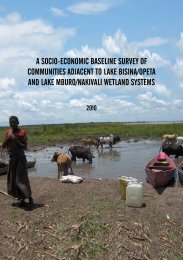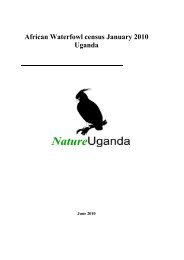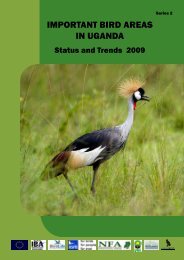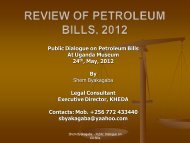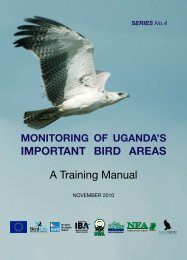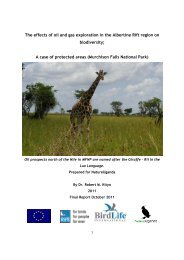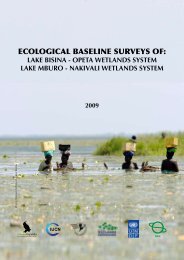the economic valuation of the proposed ... - Nature Uganda
the economic valuation of the proposed ... - Nature Uganda
the economic valuation of the proposed ... - Nature Uganda
Create successful ePaper yourself
Turn your PDF publications into a flip-book with our unique Google optimized e-Paper software.
Table 16: Value <strong>of</strong> Growing Stock<br />
Class Volume (m 3 ) Value (Shs millions)<br />
I 113,889 19,677<br />
II 171,380 17,568<br />
III 262,272 22,657<br />
Totals 547,541 59,902<br />
Source: NFA (2007)<br />
From information based on a pilot study at <strong>the</strong> NFA<br />
and based on estimates used by Moyini (2006), average<br />
stumpage values per cubic metre (at 100 percent<br />
management costs) for <strong>the</strong> different utilisation classes<br />
were: Ushs 172,770 for Class I; Ushs 102,511 for Class<br />
II; and Ushs 86,386 for Class III 7 (Table 17). From <strong>the</strong><br />
foregoing, <strong>the</strong> value <strong>of</strong> <strong>the</strong> standing timber in <strong>the</strong><br />
Compartments <strong>proposed</strong> for degazettement would be<br />
as follows above:<br />
Therefore, <strong>the</strong> value <strong>of</strong> <strong>the</strong> standing timber is Ushs<br />
59,902,000,000 or US $ 35,236,471.<br />
7 Historically, purchasers <strong>of</strong> standing timber have paid in<br />
excess <strong>of</strong> <strong>the</strong> NFA’s reserve prices during timber auction exercises.<br />
Hence, <strong>the</strong> reserve prices should be considered relatively conservative.<br />
Table 17: Value <strong>of</strong> Annual Exploitable Timber Yield<br />
38<br />
Value <strong>of</strong> annual timber benefit stream<br />
According to Karani et al (1997) a forest inventory<br />
carried out in 1993 revealed that Mabira had an annual<br />
exploitable timber yield based on trees <strong>of</strong> diameter<br />
50cm and above and a 60-year felling cycle <strong>of</strong> 1m 3 /ha/<br />
year. This is based on selective logging or what is known<br />
as reduced impact logging (RIL). Allowing for in-growth<br />
and considering a felling regime based on 40cm instead<br />
<strong>of</strong> 50cm dbh as a minimum, <strong>the</strong> harvestable volume is<br />
increased by 24 percent. Hence <strong>the</strong> estimates <strong>of</strong> Karani<br />
et al (1997) were adjusted upwards by 24 percent, to<br />
give annual exploitable volume <strong>of</strong> 1,868m 3 /year Class<br />
I, 2,803 m 3 /year Class II and 4,240 m 3 /year for Class III<br />
(Table 18). Using <strong>the</strong> same average stumpage values as<br />
reported earlier, <strong>the</strong> annual stream <strong>of</strong> timber benefits<br />
which would be foregone are as follows:<br />
Class Volume (m 3 /year Value (Shs / year)<br />
I 1,868 332,734,360<br />
II 2,803 287,338,333<br />
III 4,240 366,276,640<br />
Totals 8,911 986,349,333<br />
Source: Karani et al. (1997)<br />
From <strong>the</strong> foregoing, <strong>the</strong> value <strong>of</strong> <strong>the</strong> annual exploitable<br />
timber yield which would be foregone as a result <strong>of</strong><br />
degazettement becomes Ushs 986,349,333/year. The<br />
equivalent present value at 12 percent social cost <strong>of</strong><br />
capital would be Ushs 8,219,577,775 (or US$ 4,835,046).<br />
The Economic Valuation <strong>of</strong> <strong>the</strong> Proposed Degazettement <strong>of</strong> Mabira CFR | 2011



